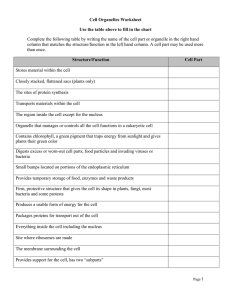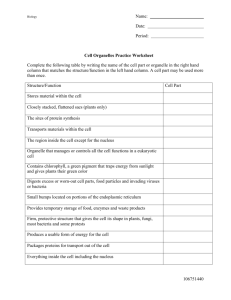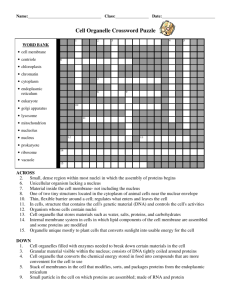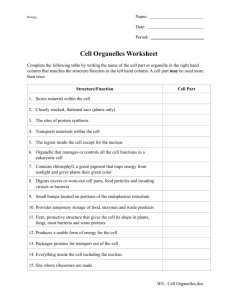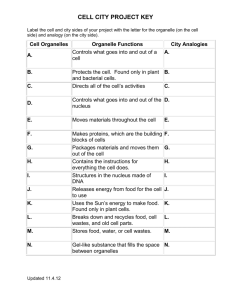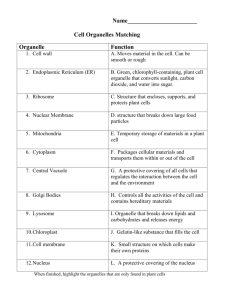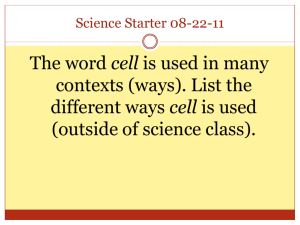Unit 3 Study Sheet #4: CELL ORGANELLES
advertisement
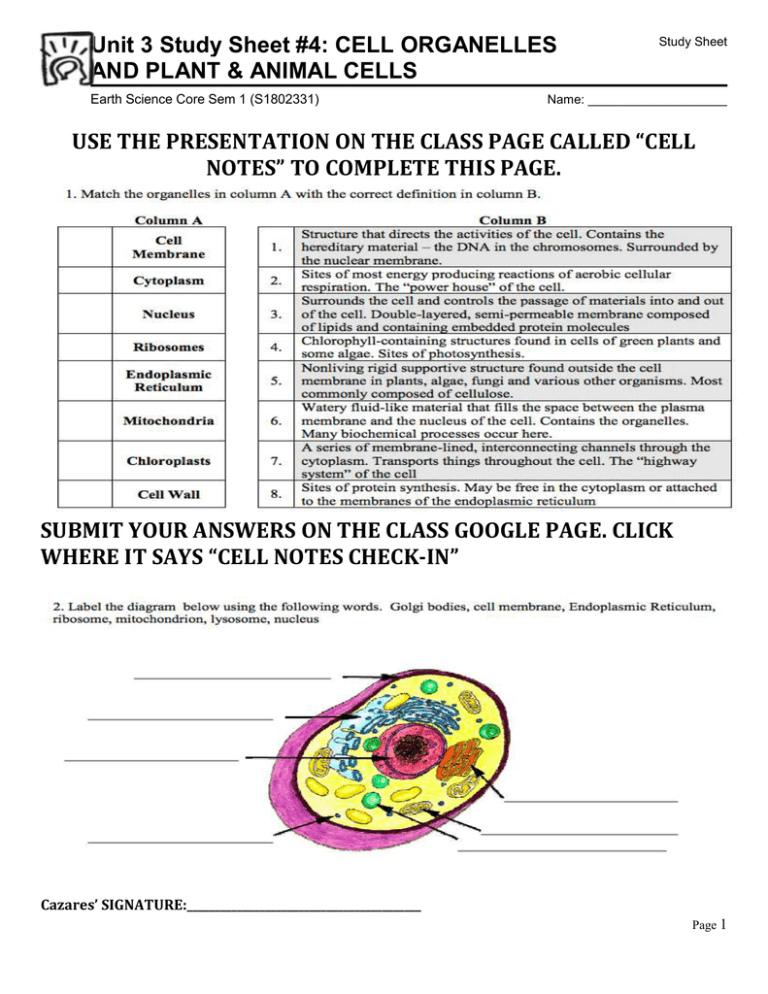
Unit 3 Study Sheet #4: CELL ORGANELLES AND PLANT & ANIMAL CELLS Earth Science Core Sem 1 (S1802331) Study Sheet Name: ____________________ USE THE PRESENTATION ON THE CLASS PAGE CALLED “CELL NOTES” TO COMPLETE THIS PAGE. SUBMIT YOUR ANSWERS ON THE CLASS GOOGLE PAGE. CLICK WHERE IT SAYS “CELL NOTES CHECK-IN” Cazares’ SIGNATURE:__________________________________________ Page 1 Organelle CELL WALL CELL MEMBRANE Description Rigid, tough, made of cellulose Thin, covering, protects cells CYTOPLASM Jelly like substance that contains organelles NUCLEUS Dense, ball shaped structure, contains DNA Thin covering over the nucleus Small dark area in the nucleus In the nucleus, made of DNA and protein, contains genes Clear, tubular system of tunnels throughout the cell Small specks made of RNA. Found in cytoplasm or on the endoplasmic reticulum Location in the cytoplasm, bean shaped NUCLEAR MEMBRANE NUCLELOUS CHROMATIN ENDOPLASMIC RETICULUM RIBOSOME MITOCHONDRIA VACUOLE Large open storage area, smaller in animal cells CHLOROPLAST Green structures that contain chlorophyll GOLGI BODY Small bags with tubes connecting them LYOSOME Small, round structures, containing enzymes Small cylindrical CENTRIOLE Function Protects and supports the cell Protects the cell, performs active transport and passive transport, moves materials in and out of the cell, communication Pads and supports organelles inside the cell. Moves by cyclosis Controls all of the cell’s activities Covers and protects the nucleus Produces ribosome’s Animal, Plant or Both Plant Both Both Both Both Both Provides instructions Both for the cells activities, (growth, reproduction) Transports materials Both like proteins around the cell Makes proteins Both Supplies energy or ATP for the cell through cell respiration using glucose and oxygen Storage tank for food, water, wastes or enzymes Captures sunlight and uses it to produce food through photosynthesis Packages and secrets proteins for use in and out of the cell Digests older cell parts, food or other objects Used with the spindle apparatus during mitosis Both Both Plant Both Both Animal Page 2 3. USE THE INFORMATION ON THE TABLE TO COMPLETE THE CELL CHART: Complete the following table by writing the name of the cell part or organelle in the right hand column that matches the structure/function in the left hand column. A cell part may be used more than once. Structure/Function Cell Part Stores material within the cell Closely stacked, flattened sacs (plants only) The sites of protein synthesis Transports materials within the cell The region inside the cell except for the nucleus Organelle that manages or controls all the cell functions in a eukaryotic cell Contains chlorophyll, a green pigment that traps energy from sunlight and gives plants their green color Digests excess or worn-out cell parts, food particles and invading viruses or bacteria Small bumps located on portions of the endoplasmic reticulum Provides temporary storage of food, enzymes and waste products Firm, protective structure that gives the cell its shape in plants, fungi, most bacteria and some protests Produces a usable form of energy for the cell Packages proteins for transport out of the cell Everything inside the cell including the nucleus Site where ribosomes are made The membrane surrounding the cell Provides support for the cell, has two “subparts” Name for the collection of DNA in the nucleus of eukaryotic cells Consist of hollow tubes which provide support for the cell Small hair-like structures used for movement or sensing things Composed of a phospholipid bilayer Longer whip-like structures used for movement GO TO THE CLASS GOOGLE PAGE AND SUBMIT YOU ANSWERS Page 3 4. DESCRIBE THE DIFFERENCE BETWEEN AN ANIMAL CELL AND A PLANT CELL USE THE INFORMATION FROM THIS HANDOUT AND PAGES 14-18 IN APEX 3.1.3 (YOUR RESPONSE MUST BE AT LEAST 1 PARAGRAPH WITH 5-7 SENTENCES) SUBMIT YOU ANSWER ON THE CLASS GOOGLE SITE. CLICK WHERE IT SAYS “DIFFERENCE BETWEEN ANIMAL AND PLANT CELLS” 5. PICK AN ORGANELLE FROM THIS LIST (CELL MEMBRANE, CYTOPLASM, NUCLEUS, RIBOSOMES, ENDOPLASMIC RETICULUM, MITOCHONDRIA, CHLOROPLASTS, CELL WALL). The organelle I am choosing is: ________________________________________________ This organelle is found in ________________________________________ (plant cells, animal cells, both plant and animal cells) Describe the organelle (what does it look like?)_______________________________________________ _________________________________________________________________________________________________________ _________________________________________________________________________________________________________ What is the primary function of this organelle (what does it do in the cell): ____________ _________________________________________________________________________________________________________ _________________________________________________________________________________________________________ _________________________________________________________________________________________________________ Cazares’ Signature: ___________________________________________ Page 4 Page 5



